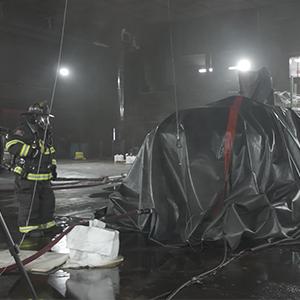
EV Fires vs. Gas-Powered Vehicle Fires: Air Contamination Risks Explored in a New Article
With more electric vehicles on the road than ever before, both the fire service and researchers are asking about the threats posed when EVs catch fire.
UL Research Institutes’ fire safety experts recently published a paper on this topic with our collaborators at the National Institute for Occupational Safety and Health, Duke University, and UL Solutions. The paper compares the air contamination from EV and gas-powered vehicle fires to better understand the differences in smoke composition and potential exposure risks posed to first responders.
Researchers Burned Nine Vehicles to Compare Air Contamination from EV Fires and Gas Vehicle Fires
To characterize and compare the air contamination from EV and gas-powered vehicle fires, researchers conducted full-scale fire experiments on six EVs and three gas-powered vehicles. The vehicles burned until all combustible components were consumed.
Researchers measured air contamination using two methods: active sampling, which involved battery-powered pumps collecting gases and particulates on specialized media for lab analysis, and passive sampling, which used silicone wristbands to absorb airborne chemicals over time. They placed sampling stations 3.0 meters (10 feet) in front, 4.5 meters (15 feet) behind, and 8.7 meters (28.5 feet) above each vehicle to capture a range of exposure conditions. Through the sampling, researchers measured levels of volatile organic compounds, heavy metals, acid gases, polycyclic aromatic hydrocarbons, and inhalable particulates.

Both EV Fires and Gas-Powered Vehicle Fires Contaminate Air, with EVs Emitting More Heavy Metals and Fluoride Particulate
The study revealed several important differences in the composition of smoke from EV and gas-powered vehicle fires:
- Both EV and gas-powered vehicle fires produced airborne contaminants that could pose health hazards.
- EV fires released significantly higher concentrations of heavy metals, including lithium, cobalt, nickel, and manganese.
- Fluoride particulate was found in greater concentrations than hydrogen fluoride in EV fires.
- Fluoride particulate levels were substantially higher in EV fires compared to gas-powered vehicle fires.
“We expected both vehicle types to produce high concentrations of compounds that can be associated with negative health impacts, and this study confirmed that. While there are some differences between the two vehicle types, it remains critical for firefighters to wear their full personal protective equipment, including their self-contained breathing apparatus, while fighting vehicle fires, regardless of vehicle type.”
—Richard Kesler
Research Engineer
UL Research Institutes | Fire Safety Research Institute
Understanding the chemical makeup of vehicle fire smoke is essential for protecting firefighters and bystanders who may be exposed. This research offers critical insights into the unique air contamination risks associated with EV fires and highlights the importance of ongoing research to inform health and safety practices.
About Fire Safety Journal
Fire Safety Journal is the leading publication dealing with all aspects of fire safety engineering. Its scope is purposefully wide, as it is deemed important to encourage papers from all sources within this multidisciplinary subject, thus providing a forum for its further development as a distinct engineering discipline. This is an essential step towards gaining a status equal to that enjoyed by the other engineering disciplines.

